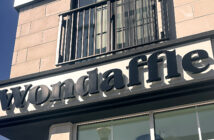A college education comes with a hefty price tag — tuition, room and board, and more. The cost of textbooks, however, has separated itself from this collection of college expenses.
Since 2006, the price of college textbooks has increased by 87.5 percent, according to the Bureau of Labor and Statistics. The second most inflated expense is college tuition and fees at 62.7 percent, which is 25 percent below the price increase in textbooks.
Many publishers have hiked up prices and produced new editions in an attempt to compete with online offerings in the once stagnant textbook industry. College students are turning to cost-saving alternatives like choosing used or rental textbooks, sharing textbooks with peers, borrowing from the library and even forgoing a textbook all together.
This cycle has brought students, faculty and publishers to a crossroads, where all parties are frustrated and searching for a solution.
Michael Santoro, a management professor who has worked at Lehigh for 19 years, said the increase in textbook prices has been “exponential,” especially in the last five to seven years.
At Lehigh, 75 percent of respondents to an Office of Financial Aid survey said they pay less than $500 for textbooks. The other 25 percent said they pay more than $500 on textbooks. The office did not provide a further breakdown of the values within that range.
Brian Adler, the manager of the Lehigh University Bookstore, wrote in an email that Lehigh students are slightly more likely to purchase a new textbook, closely followed by rentals, used, and then digital, which is only 1 percent of bookstore textbook sales. About 85 percent of textbooks are available for rent, but not all materials are offered in this format.
Adler wrote that publishers set the textbook prices and the bookstore applies an industry standard markup to the publisher price, which is used to cover costs like freight, labor and maintaining the bookstore itself. A percentage of bookstore revenue is paid to Lehigh to help fund scholarships, special programs and faculty positions.
Mark Canney, the manager for lending services at Fairchild-Martindale and Linderman libraries, said one reason the textbook market is so inflated is because there is no consumer choice. This means students, who are the buyers, do not have a say in what they are purchasing. Thus, prices are escalating because a small number of publishers control the majority of the textbook market.
Traditional college bookstores are not the only successful retailer in the textbook market anymore. Many students are ordering books from websites like Chegg and Amazon.
Suzanne Fernandez, the director of organic chemistry, said her students are savvy when it comes to buying textbooks because she can see they are rented or from online retailers, not necessarily from the bookstore.
Organic Chemistry I and II students are required to purchase textbook access codes, which provide students with online content and supplementary material. Fernandez said publishers are differentiating their textbooks from one another through technology because many textbooks are similar in content, and there is greater accessibility to used books. These online components are key in her search for a textbook because they are important learning tools and enhance the curriculum.
Fernandez said she is price-conscious when choosing a textbook because she would rather students have a textbook than not be able to buy one at all because it’s too expensive. She said many of her students use old editions because even though there might be new examples and different problem numbers, the fundamentals are the same.
However, in many other departments, this is not the case. Santoro said management is a dynamic field, so using the most recent textbook edition is vital because the class studies the latest trends and case studies.
“As a faculty member, my objective is always the substance and topic areas, so to me, my No. 1 goal is to ensure students are being trained,” Santoro said. “Since my students are seniors, I have to make sure they are up to speed on contemporary issues, so when they leave, they can hit the ground running after graduation.”
When choosing a textbook for Strategic Management in a Global Environment, Santoro lays out the course objectives and decides what he is trying to accomplish. Then he chooses the textbook that best fits these criteria while considering factors like price, readability and size. He works with the bookstore by alerting them to the number of students in the class to ensure there are enough books in stock.
Santoro said he has a friend who works in the textbook publishing industry and understands how labor intensive the production and promotion of a textbook can be. He said it takes a lot of time, effort and money to create and revise textbooks.
Jean Kwon, ’17, feels similarly. She said from the perspective of the researchers, it takes a lot of time and effort to put together big textbooks, especially because they have to be designed in a specific way to be teachable.
Kwon studies bioengineering and estimates she spends $300 per semester on textbooks. She prefers to buy through Amazon because it’s convenient and she assumes cheaper than the bookstore. She typically waits to to see if she needs textbooks for the class before buying them. If she can get away without the textbook, she won’t purchase it.
Students have many other ways to dodge paying full price for textbooks.
The Lehigh libraries offer inter-library loan services to obtain books and supplementary materials from other participating Pennsylvania Academic Library Consortium Inc. libraries. As a work-study student assistant at FML, Kwon said a lot of students see this system as an attractive way to get their textbooks.
“While we discourage the use of inter-library loan services for textbooks, we can’t always prevent it,” Canney said. “Sometimes students discover the books in the portal because it’s unmediated. With 7,000 students, this doesn’t scale as a service that we can provide, and it is understood that required textbooks are part of what students are supposed to purchase.”
Often, partner libraries don’t offer the most current edition and have 100-day loan periods, so these books have to be returned before finals.
“Students need to express their voice to make faculty aware that high textbook prices are a concern for them,” Canney said, “especially when there are low-cost alternatives for many introduction classes.”
One of these alternatives includes open-access courseware, which is material such as textbook chapters and journals published online and available for free on websites such as Openstax and Flat World. Canney said this is not a movement that has caught on with much of the faculty.
Fernandez said this is because the quality of this online material can be questionable, so it’s difficult for professors to determine if it’s good enough to be used for class. She said, however, publishers may be faced with a challenge as the quality of online material becomes more reliable in the future.
Textbooks are such a significant cost that they are even factored into financial aid, and some students can use their financial aid to cover textbook costs. Jason Shumaker, the senior associate director of the Office of Financial Aid, said financial aid eligibility is calculated by subtracting expected family contribution, or what the school measures a family can contribute to one year’s cost, from the cost of attendance said. The cost of attendance includes both direct costs like tuition and fees as well as indirect costs, which is the category that textbooks fall into.
Lehigh’s cost of attendance for the 2016-17 school year is estimated to be $63,075. Within this cost-of-attendance number, the Office of Financial Aid has factored in $1,000 a year, or $500 a semester, for textbooks for full-time students. Shumaker said if the total financial aid credits exceed money owed on a student’s account, then this surplus can be used towards textbooks or as the student sees fit.
While there are alternatives for textbooks in sight, it can be difficult to break away from institutional practices and opinions remain divided on the issue, as a top-tier diploma doesn’t come cheap.
“In the end, plus or minus $20 isn’t that big of a deal,” Santoro said. “If a textbook doesn’t cover the right topics and is not up to the level it needs to be for the course, then what’s the point?”






Comment policy
Comments posted to The Brown and White website are reviewed by a moderator before being approved. Incendiary speech or harassing language, including comments targeted at individuals, may be deemed unacceptable and not published. Spam and other soliciting will also be declined.
The Brown and White also reserves the right to not publish entirely anonymous comments.